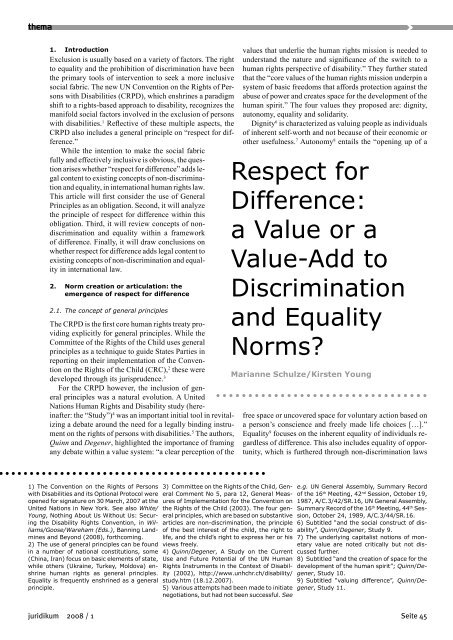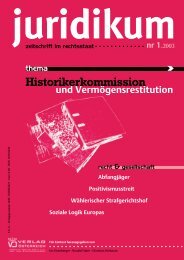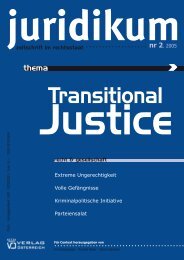Download - juridikum, zeitschrift für kritik | recht | gesellschaft
Download - juridikum, zeitschrift für kritik | recht | gesellschaft
Download - juridikum, zeitschrift für kritik | recht | gesellschaft
Sie wollen auch ein ePaper? Erhöhen Sie die Reichweite Ihrer Titel.
YUMPU macht aus Druck-PDFs automatisch weboptimierte ePaper, die Google liebt.
thema<br />
1. Introduction<br />
Exclusion is usually based on a variety of factors. The right<br />
to equality and the prohibition of discrimination have been<br />
the primary tools of intervention to seek a more inclusive<br />
social fabric. The new UN Convention on the Rights of Persons<br />
with Disabilities (CRPD), which enshrines a paradigm<br />
shift to a rights-based approach to disability, recognizes the<br />
manifold social factors involved in the exclusion of persons<br />
with disabilities. 1 Reflective of these multiple aspects, the<br />
CRPD also includes a general principle on “respect for difference.”<br />
While the intention to make the social fabric<br />
fully and effectively inclusive is obvious, the question<br />
arises whether “respect for difference” adds legal<br />
content to existing concepts of non-discrimination<br />
and equality, in international human rights law.<br />
This article will first consider the use of General<br />
Principles as an obligation. Second, it will analyze<br />
the principle of respect for difference within this<br />
obligation. Third, it will review concepts of nondiscrimination<br />
and equality within a framework<br />
of difference. Finally, it will draw conclusions on<br />
whether respect for difference adds legal content to<br />
existing concepts of non-discrimination and equality<br />
in international law.<br />
2. Norm creation or articulation: the<br />
emergence of respect for difference<br />
2.1. The concept of general principles<br />
The CRPD is the first core human rights treaty providing<br />
explicitly for general principles. While the<br />
Committee of the Rights of the Child uses general<br />
principles as a technique to guide States Parties in<br />
reporting on their implementation of the Convention<br />
on the Rights of the Child (CRC), 2 these were<br />
developed through its jurisprudence. 3<br />
For the CRPD however, the inclusion of general<br />
principles was a natural evolution. A United<br />
Nations Human Rights and Disability study (hereinafter:<br />
the “Study”) 4 was an important initial tool in revitalizing<br />
a debate around the need for a legally binding instrument<br />
on the rights of persons with disabilities. 5 The authors,<br />
Quinn and Degener, highlighted the importance of framing<br />
any debate within a value system: “a clear perception of the<br />
values that underlie the human rights mission is needed to<br />
understand the nature and significance of the switch to a<br />
human rights perspective of disability.” They further stated<br />
that the “core values of the human rights mission underpin a<br />
system of basic freedoms that affords protection against the<br />
abuse of power and creates space for the development of the<br />
human spirit.” The four values they proposed are: dignity,<br />
autonomy, equality and solidarity.<br />
Dignity 6 is characterized as valuing people as individuals<br />
of inherent self-worth and not because of their economic or<br />
other usefulness. 7 Autonomy 8 entails the “opening up of a<br />
Respect for<br />
Difference:<br />
a Value or a<br />
Value-Add to<br />
Discrimination<br />
and Equality<br />
Norms?<br />
Marianne Schulze/Kirsten Young<br />
·································<br />
free space or uncovered space for voluntary action based on<br />
a person’s conscience and freely made life choices […].”<br />
Equality 9 focuses on the inherent equality of individuals regardless<br />
of difference. This also includes equality of opportunity,<br />
which is furthered through non-discrimination laws<br />
1) The Convention on the Rights of Persons<br />
with Disabilities and its Optional Protocol were<br />
opened for signature on 30 March, 2007 at the<br />
United Nations in New York. See also White/<br />
Young, Nothing About Us Without Us: Securing<br />
the Disability Rights Convention, in Williams/Goose/Wareham<br />
(Eds.), Banning Landmines<br />
and Beyond (2008), forthcoming.<br />
2) The use of general principles can be found<br />
in a number of national constitutions, some<br />
(China, Iran) focus on basic elements of state,<br />
while others (Ukraine, Turkey, Moldova) enshrine<br />
human rights as general principles.<br />
Equality is frequently enshrined as a general<br />
principle.<br />
3) Committee on the Rights of the Child, General<br />
Comment No 5, para 12, General Measures<br />
of Implementation for the Convention on<br />
the Rights of the Child (2003). The four general<br />
principles, which are based on substantive<br />
articles are non-discrimination, the principle<br />
of the best interest of the child, the right to<br />
life, and the child’s right to express her or his<br />
views freely.<br />
4) Quinn/Degener, A Study on the Current<br />
Use and Future Potential of the UN Human<br />
Rights Instruments in the Context of Disability<br />
(2002), http://www.unhchr.ch/disability/<br />
study.htm (18.12.2007).<br />
5) Various attempts had been made to initiate<br />
negotiations, but had not been successful. See<br />
e.g. UN General Assembly, Summary Record<br />
of the 16 th Meeting, 42 nd Session, October 19,<br />
1987, A/C.3/42/SR.16, UN General Assembly,<br />
Summary Record of the 16 th Meeting, 44 th Session,<br />
October 24, 1989, A/C.3/44/SR.16.<br />
6) Subtitled “and the social construct of disability”,<br />
Quinn/Degener, Study 9.<br />
7) The underlying capitalist notions of monetary<br />
value are noted critically but not discussed<br />
further.<br />
8) Subtitled “and the creation of space for the<br />
development of the human spirit”; Quinn/Degener,<br />
Study 10.<br />
9) Subtitled “valuing difference”, Quinn/Degener,<br />
Study 11.<br />
<strong>juridikum</strong> 2008 / 1 Seite 45
















